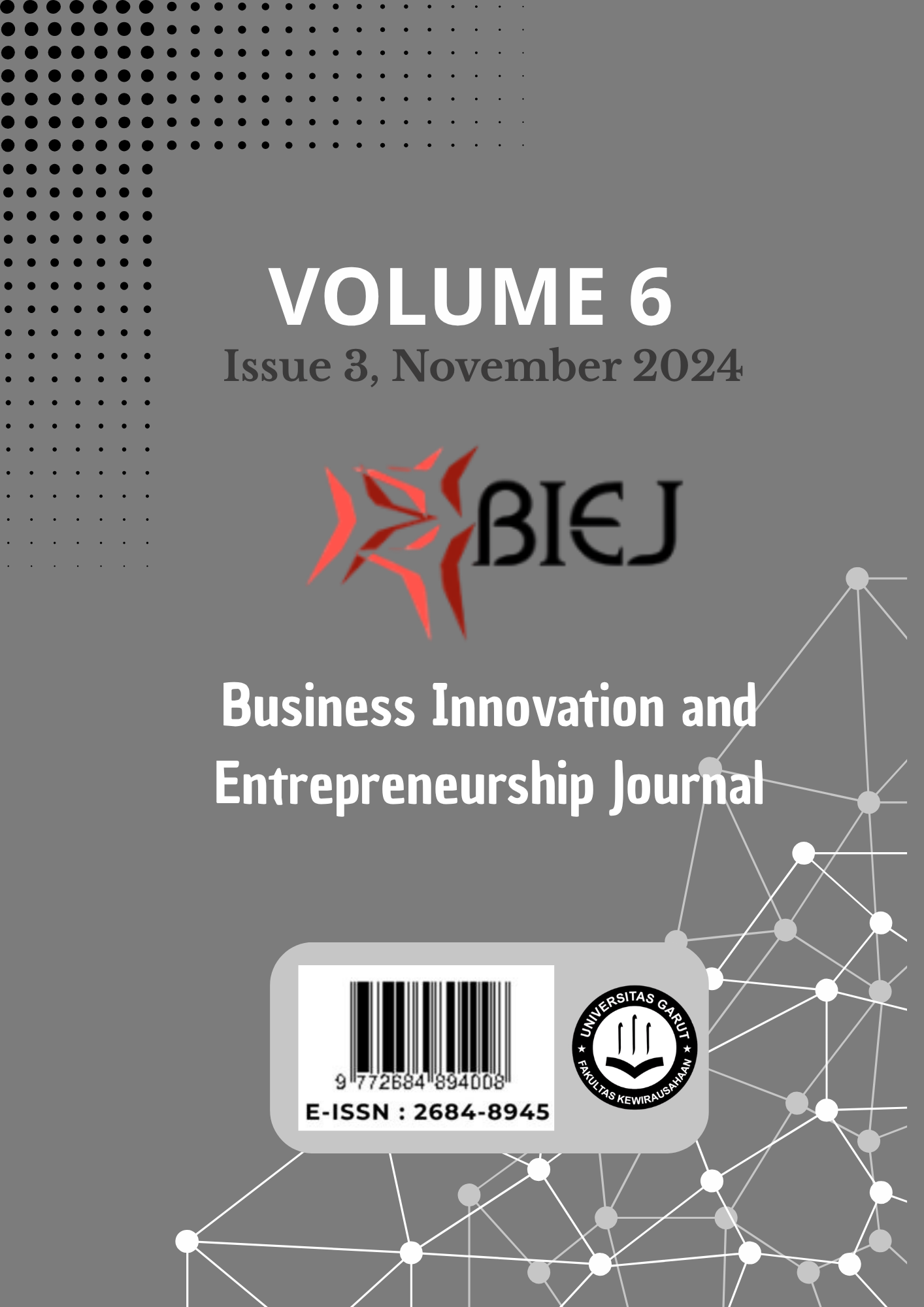Entrepreneurs' Perceptions of the Role of Social Media in Increasing Business Competitiveness
Abstract
The involvement of an active entrepreneurial community in utilizing social media can increase the effectiveness of the creative economy in the region. The purpose of this study is to analyze the use of social media to enable entrepreneurs to reach a wider audience. The research method uses a qualitative approach with a qualitative descriptive study design, sampling techniques in qualitative descriptive research often use purposive sampling. Data analysis techniques are carried out in a qualitative descriptive manner, prioritizing understanding meaning and phenomena rather than just measurement. The results of this study indicate that social media plays a role in increasing business competitiveness in the environment, social media has a complex role in improving the business sector of entrepreneurs. Social media as a tool, but a detailed understanding of how to use and design interactions is also needed to build strong relationships with consumers. Therefore, the wise use of social media can increase business competitiveness for the sustainability and growth of every entrepreneur's business.
Downloads
References
S. Wulandari and N. Supratman, “Potensi penggunaan media sosial bagi UKM,” Performa Media Ilm. Tek. Ind., vol. 17, no. 1, 2018, doi: 10.20961/performa.17.1.18922.
L. Dewi and W. Setiawan, “Pengembangan dan pelatihan sumber daya manusia di era digital marketing menuju 5.0 dengan memanfaatkan platform media sosial pada UMKM di Desa Sukasukur Kecamatan Cisayong,” J. Umum Pengabdi. Masy., vol. 2, no. 4, pp. 36–44, 2023, doi: 10.58290/jupemas.v2i4.190.
S. Maria, T. Pusriadi, Y. Hakim, and D. Darma, “The effect of social media marketing, word of mouth, and effectiveness of advertising on brand awareness and intention to buy,” J. Manaj. Indones., vol. 19, no. 2, p. 107, 2019, doi: 10.25124/jmi.v19i2.2234.
A. Primanto and F. Rahman, “Perlukah pendampingan terhadap pelaku UMKM dalam memanfaatkan media sosial sebagai saluran pemasaran strategis?,” J. Manaj. Ind. Dan Logistik, vol. 3, no. 2, pp. 93–102, 2019, doi: 10.30988/jmil.v3i02.146.
F. Zainularifin and S. Riyanto, “Pengaruh penggunaan media sosial terhadap tingkat penjualan pedagang konvensional produk pertanian di Kelurahan Kedungsari Kota Magelang pada masa pandemi COVID-19,” J. Indones. Sos. Sains, vol. 2, no. 1, pp. 32–39, 2021, doi: 10.36418/jiss.v2i1.112.
G. Abdul et al., “Information Technology Resources and Innovation Performance in Higher Education,” vol. 15, no. 04, pp. 117–125, 2021.
R. Syafitri and T. Taufiqqurrachman, “Pelatihan produksi konten untuk memasarkan destinasi wisata desa Resun Kabupaten Lingga melalui media sosial,” J. Masy. Madani Indones., vol. 2, no. 3, pp. 152–158, 2023, doi: 10.59025/js.v2i3.96.
T. Taufiqurrahman, A. Azis, and A. Sugita, “Pemberdayaan ekonomi masyarakat melalui dunia digital di era COVID-19,” Etos J. Pengabdi. Masy., vol. 3, no. 1, p. 20, 2021, doi: 10.47453/etos.v3i1.351.
D. Kushardiyanti, “Keterlibatan komunitas dalam perkembangan ekonomi kreatif Cirebon melalui perspektif ekonomi pembangunan,” JIKE J. Ilmu Komun. Efek, vol. 5, no. 2, pp. 144–155, 2022, doi: 10.32534/jike.v5i2.2493.
Andi.link, “Hootsuite (We are Social): Data Digital Indonesia 2024,” 2024. https://andi.link/hootsuite-we-are-social-data-digital-indonesia-2024/
S. Elias, T. Chiles, and B. Crawford, “Entrepreneurial imagining: how a small team of arts entrepreneurs created the world’s largest traveling carillon,” Organ. Stud., vol. 43, no. 2, pp. 203–226, 2021, doi: 10.1177/01708406211035501.
C. Abecassis, S. Mahmoud‐Jouini, D. Manceau, and J. Pereira, “Imprinting of founders’ entrepreneurial motivations on enterprises’ practices and processes: the context of creative industries,” Creat. Innov. Manag., vol. 30, no. 1, pp. 182–197, 2021, doi: 10.1111/caim.12421.
T. Thao, “Social entrepreneurship: definitional issues,” Int. J. Manag. Entrep. Res., vol. 5, no. 6, pp. 458–463, 2023, doi: 10.51594/ijmer.v5i6.506.
F. Blanco‐Mesa, E. León‐Castro, D. Bermudez-Mondragon, and M. Castro-Amado, “Forgotten motivational factors of boyacense colombian entrepreneurs: a subjective analysis of second-generation incidences,” Mathematics, vol. 9, no. 9, p. 973, 2021, doi: 10.3390/math9090973.
R. Wang, H. Zhou, and L. Wang, “The influence of psychological capital and social capital on the entrepreneurial performance of the new generation of entrepreneurs,” Front. Psychol., vol. 13, 2022, doi: 10.3389/fpsyg.2022.832682.
S. Müller, A. Kirst, H. Bergmann, and B. Bird, “Entrepreneurs’ actions and venture success: a structured literature review and suggestions for future research,” Small Bus. Econ., vol. 60, no. 1, pp. 199–226, 2022, doi: 10.1007/s11187-022-00644-3.
J. Lin and Z. Zhou, “The positioning of green brands in enhancing their image: the mediating roles of green brand innovativeness and green perceived value,” Int. J. Emerg. Mark., 2022, doi: 10.1108/IJOEM-06-2020-0657.
B. A. Mertz, A. Hass, K. C. Anderson, T. Kaskela, and L. J. Zmich, “#SocialMediaWellness: Exploring a Research Agenda and Conceptualization for Healthy Social Media Consumption,” J. Consum. Behav., vol. 23, no. 2, pp. 321–335, 2023, doi: 10.1002/cb.2179.
Syifa Rofifa Putri Rizq and Istyakara Muslichah, “Intention to Buy Halal Cosmetics based on Social Media Activities, Brand Equity, and e-WOM,” J. Ekon. Syariah Teor. dan Terap., vol. 10, no. 3, pp. 249–261, 2023, doi: 10.20473/vol10iss20233pp249-261.
A. Meier and L. Reinecke, “Social Media and Mental Health: Reviewing Effects on Eudaimonic Well-Being,” 2021, doi: 10.31234/osf.io/xvts8.
A. Maulana, “Peran Kementerian/Lembaga Negara Untuk Meningkatkan Daya Saing Kepariwisataan Indonesia,” Aspir. J. Masal. Sos., vol. 13, no. 2, 2022, doi: 10.46807/aspirasi.v13i2.2916.
Z. Novandaya, H. B. Wijaya, M. I. H. Wijaya, H. N. Azmi, and H. Kurniawati, “Pemanfaatan Penilaian Indeks Daya Saing Daerah Untuk Optimalisasi Sektor Unggulan Dan Berkembang Pada Aglomerasi Wilayah Kedungsepur,” J. Penataan Ruang, p. 70, 2022, doi: 10.12962/j2716179x.v17i2.12835.
B. Ma’ruf and A. Bisri, “Konsistensi Pengaruh Sumberdaya Dalam Mendukung Daya Saing Galangan Kapal Nasional,” Maj. Ilm. Pengkaj. Ind., vol. 12, no. 3, pp. 173–180, 2023, doi: 10.29122/mipi.v12i3.3076.
R. Mardikaningsih, “Strategi Inovasi Dan Pemasaran Media Sosial Untuk Meningkatkan Keunggulan Kompetitif Umkm Di Kota Surabaya,” J. Baruna Horiz., vol. 6, no. 2, pp. 58–67, 2023, doi: 10.52310/jbhorizon.v6i2.101.
M. D. D. Maharani and A. C. M. Haeng, “Memorable Torism Experience Sebagai Daya Saing Keberlanjutan Ekowisata Halal,” Semin. Nas. Pariwisata Dan Kewirausahaan, vol. 2, pp. 1–9, 2023, doi: 10.36441/snpk.vol2.2023.94.
Z. b. A. Jalil and N. H. Zakaria, “Social Media Adoption and Business Performance Among Bumiputera Micro-Entrepreneurs in Malaysia: Is Entrepreneurial Orientation a Missing Link?,” Int. J. Relig., vol. 5, no. 1, pp. 100–109, 2024, doi: 10.61707/70wt9747.
A. M. Lawal, I. M. Salisu, and A. Bappa-yaya, “Roles of Social Media in Empowering Micro Scale Women Entrepreneurs in Gombe State, Nigeria,” J. Glob. Soc. Sci., vol. 3, no. 10, pp. 47–63, 2022, doi: 10.31039/jgss.v3i10.16.
S. Marneros, G. Papageorgiou, and A. Efstathiades, “Sustainability Management, Technological Innovation and Corporate Social Responsibility for Social Media Small to Medium-Sized Enterprises (SMEs),” Eur. Conf. Innov. Entrep., vol. 18, no. 1, pp. 571–579, 2023, doi: 10.34190/ecie.18.1.1848.
P. Limilia and N. Aristi, “Literasi Media Dan Digital Di Indonesia: Sebuah Tinjauan Sistematis,” J. Komun., vol. 8, no. 2, pp. 205–222, 2019, doi: 10.33508/jk.v8i2.2199.
A. O. L. I. Noya, D. A. G. Wahyuni, and H. T. Nugraha, “Kajian Ekstensifikasi Barang Kena Cukai Pada Ban Karet,” J. Perspekt. Bea Dan Cukai, vol. 7, no. 2, pp. 189–212, 2023, doi: 10.31092/jpbc.v7i2.2108.
J. W. Creswell, Research Design Pendekatan Kualitataif, Kuantitatif, dan Mixed. Yogyakarta: pustaka pelajar, 2016.
L. F. Fitri, A. Santoso, and F. Taufiqurrahman, “Proses Fonologis Bahasa Gaul Generasi ‘Z’ Di Sosial Media (Analisis Fonologi Generatif),” J. Onoma Pendidik. Bhs. Dan Sastra, vol. 9, no. 1, pp. 80–88, 2023, doi: 10.30605/onoma.v9i1.2126.
S. P. Ardani and W. L. Harahap, “Strategi Konten Kreatif Untuk Meningkatkan Engagement Umkm Di Social Media,” J. DKV, vol. 2, no. 2, pp. 136–143, 2024, doi: 10.62375/jdkv.v2i2.228.
I. Mulyawan, D. Saefuloh, H. F. Wijaya, and W. Rafdinal, “Sikap Pada Iklan Media Sosial Instagram Dan Kesadaran Merek Terhadap Niat Pembelian Pada Generasi Y Dan Z,” J. Ris. Bisnis Dan Investasi, vol. 6, no. 3, pp. 143–153, 2021, doi: 10.35313/jrbi.v6i3.2248.
S. Juminawati, S. Syamsulbahri, and I. Harsono, “Analisis Pengaruh Orientasi Pasar, Inovasi Produk, Dan Strategi Pemasaran Terhadap Daya Saing UKM Di Pasar Lokal: Studi Pada Industri Kreatif Di Bandung, Indonesia,” J. Bisnis Dan Manaj. West Sci., vol. 3, no. 01, pp. 1–10, 2024, doi: 10.58812/jbmws.v3i01.970.



























